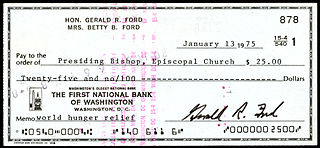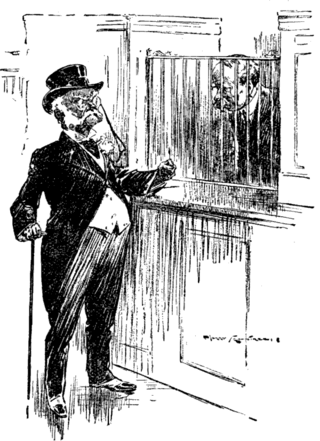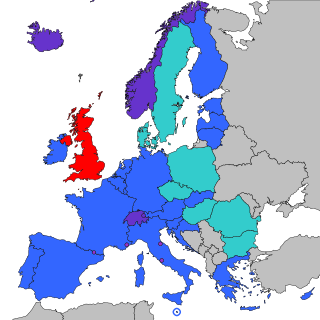Related Research Articles

A debit card, also known as a check card or bank card, is a payment card that can be used in place of cash to make purchases. The card usually consists of the bank's name, a card number, the cardholder's name, and an expiration date, on either the front or the back. Many new cards now have a chip on them, which allows people to use their card by touch (contactless), or by inserting the card and keying in a PIN as with swiping the magnetic stripe. Debit cards are similar to a credit card, but the money for the purchase must be in the cardholder's bank account at the time of the purchase and is immediately transferred directly from that account to the merchant's account to pay for the purchase.

In the United States, the ACH Network is the national automated clearing house (ACH) for electronic funds transfers established in the 1960s and 1970s. It is a financial utility owned by US banks, and is one of the largest payments networks in the United States, both by volume and by customer reach; virtually every bank account in the US, whether personal or commercial, is connected to the network.

A transaction account, also called a checking account, chequing account, current account, demand deposit account, or share account at credit unions, is a deposit account or bank account held at a bank or other financial institution. It is available to the account owner "on demand" and is available for frequent and immediate access by the account owner or to others as the account owner may direct. Access may be in a variety of ways, such as cash withdrawals, use of debit cards, cheques and electronic transfer. In economic terms, the funds held in a transaction account are regarded as liquid funds. In accounting terms, they are considered as cash.

A giro transfer, often shortened to giro, is a payment transfer between current bank accounts and initiated by the payer, not the payee. The debit card has a similar model. Giros are primarily used in Europe; although electronic payment systems exist in the United States, it is not possible to perform third-party transfers with them. In the European Union, the Single Euro Payments Area (SEPA) allows electronic giro or debit card payments in euros to be executed to any euro bank account in the area.

A cheque is a document that orders a bank, building society to pay a specific amount of money from a person's account to the person in whose name the cheque has been issued. The person writing the cheque, known as the drawer, has a transaction banking account where the money is held. The drawer writes various details including the monetary amount, date, and a payee on the cheque, and signs it, ordering their bank, known as the drawee, to pay the amount of money stated to the payee.

Bacs Payment Schemes Limited (Bacs), previously known as Bankers' Automated Clearing System, is responsible for the clearing and settlement of UK automated direct debit and Bacs Direct Credit and the provision of third-party services. Bacs became a subsidiary of Pay.UK on 1 May 2018, and responsibility for direct debit, Bacs Direct Credit, the Current Account Switch Service, Cash ISA Transfer Service and the Industry Sort Code Directory was given to Pay.UK.
A chargeback is a return of money to a payer of a transaction, especially a credit card transaction. Most commonly the payer is a consumer. The chargeback reverses a money transfer from the consumer's bank account, line of credit, or credit card. The chargeback is ordered by the bank that issued the consumer's payment card. In the distribution industry, a chargeback occurs when the supplier sells a product at a higher price to the distributor than the price they have set with the end user. The distributor submits a chargeback to the supplier so they can recover the money lost in the transaction.

Electronic funds transfer (EFT) is the transfer of money from one bank account to another, either within a single financial institution or across multiple institutions, via computer-based systems.

An overdraft occurs when something is withdrawn in excess of what is in a current account. For financial systems, this can be funds in a bank account. In these situations the account is said to be "overdrawn". In the economic system, if there is a prior agreement with the account provider for an overdraft, and the amount overdrawn is within the authorized overdraft limit, then interest is normally charged at the agreed rate. If the negative balance exceeds the agreed terms, then additional fees may be charged and higher interest rates may apply.
A merchant account is a type of bank account that allows a seller, known as the merchant, to accept payments by debit or credit cards. A merchant account is established under an agreement between an acceptor and a merchant acquiring bank for the settlement of payment card transactions. In some cases a payment processor, payment service provider, independent sales organization (ISO), or member service provider (MSP) is also a party to the merchant agreement and can act as middle man between the merchant and the bank.
Friendly fraud, also known as chargeback fraud occurs when a consumer makes an online shopping purchase with their own credit card, and then requests a chargeback from the issuing bank after receiving the purchased goods or services. Once approved, the chargeback cancels the financial transaction, and the consumer receives a refund of the money they spent. Dependent on the payment method used, the merchant can be accountable when a chargeback occurs.
A payment is the tender of something of value, such as money or its equivalent, by one party to another in exchange for goods or services provided by them, or to fulfill a legal obligation or philanthropy desire. The party making the payment is commonly called the payer, while the payee is the party receiving the payment. Whilst payments are often made voluntarily, some payments are compulsory, such as payment of a fine.

Payment cards are part of a payment system issued by financial institutions, such as a bank, to a customer that enables its owner to access the funds in the customer's designated bank accounts, or through a credit account and make payments by electronic transfer with a payment terminal and access automated teller machines (ATMs). Such cards are known by a variety of names, including bank cards, ATM cards, client cards, key cards or cash cards.

The Single Euro Payments Area (SEPA) is a payment integration initiative of the European Union for simplification of bank transfers denominated in euros. As of 2020, there were 36 members in SEPA, consisting of the 27 member states of the European Union, the four member states of the European Free Trade Association, and the United Kingdom. Some microstates participate in the technical schemes: Andorra, Monaco, San Marino, and Vatican City.
A floor limit is the amount of money above which debit card or credit card transactions must be authorized online by their Issuing banks. The limit can vary from store to store. Floor limits have become less significant as credit cards & most of the debit cards started being processed electronically, and all transactions are typically authorized online by sending the Authorization request to their issuing banks.
A standing order is an instruction a bank account holder gives to their bank to pay a set amount at regular intervals to another's account. The instruction is sometimes known as a banker's order.
Authorization hold is a service offered by credit and debit card providers whereby the provider puts a hold of the amount approved by the cardholder, reducing the balance of available funds until the merchant clears the transaction, after the transaction is completed or aborted, or because the hold expires.

Credit card fraud is an inclusive term for fraud committed using a payment card, such as a credit card or debit card. The purpose may be to obtain goods or services or to make payment to another account, which is controlled by a criminal. The Payment Card Industry Data Security Standard is the data security standard created to help financial institutions process card payments securely and reduce card fraud.

A credit card is a payment card, usually issued by a bank, allowing its users to purchase goods or services, or withdraw cash, on credit. Using the card thus accrues debt that has to be repaid later. Credit cards are one of the most widely used forms of payment across the world.

An automated clearing house (ACH) is a computer-based electronic network for processing transactions, usually domestic low value payments, between participating financial institutions. It may support both credit transfers and direct debits. The ACH system is designed to process batches of payments containing numerous transactions, and it charges fees low enough to encourage its use for low-value payments.
References
- ↑ "What is Direct Debit?". www.directdebit.co.uk. Retrieved 2023-01-21.
- ↑ "Direct Debit System & Recurring Payments | Noorbank". www.noorbank.com. Retrieved 2018-01-23.
- ↑ "Alastair Hanton Obituary" . The Times. June 17, 2021.
- ↑ "How direct debit benefits businesses and payers" . Retrieved 2022-12-07.
- ↑ "FAQ Friday – How much does it cost to process Direct Debit payments?" . Retrieved 2022-12-07.
- ↑ EU Regulation 260/2012
- ↑ "Debit Cards Set To Overtake Cash in 2018, Three Years Earlier Than Expected". Payments UK. 2017-05-25. Archived from the original on 2017-06-29. Retrieved 2017-06-14.
- ↑ "About". Bacs. Retrieved 2017-06-14.
- ↑ "How Direct Debits began in the UK". YouTube . 8 April 2014. Retrieved 8 September 2016.
- ↑ "Automated payments at all-time high as Bacs breaks six billion barrier". Business Money. 20 January 2016.
- ↑ "Bacs corporate overview". Bacs. Archived from the original on 2016-03-03. Retrieved 2016-03-02.
- ↑ "Automated payments at all-time high as Bacs breaks six billion barrier". business-money.com. 20 January 2016. Retrieved 2016-03-02.
- ↑ "Bacs achievements 2016" (PDF). Bacs. 2016.
- ↑ "Number of Direct Debit transactions expected to grow by 2026". SmartDebit. 2017-05-30. Retrieved 2017-06-14.
- ↑ "BACS: Paperless Direct Debit". Bacs. Archived from the original on 21 December 2012. Retrieved 29 May 2012.
- ↑ "The Direct Debit Guarantee". Bacs. Archived from the original on 26 May 2012. Retrieved 29 May 2012.
- ↑ "Direct Debit vs recurring card payments". SmartDebit. 2017-06-26. Retrieved 2017-07-05.
- ↑ "What is a Direct Debit?". AccessPay. 27 September 2016.
- ↑ "What's involved in taking payments by Direct Debit?". Eazy Collect. Retrieved 29 May 2012.
- ↑ "What happens when a Direct Debit is inactive?". Inactive Direct Debits. BACS.
- ↑ Montia, Gill (November 19, 2010). "Sharp increase in direct debit fraud". Banking Times. Archived from the original on August 22, 2016.
- ↑ "North Wales News". www.dailypost.co.uk. Retrieved 2019-04-09.
- ↑ "UK Banks Responsible For Direct Debit Scams – Don't Use Direct Debit Or You Could Lose Your Money". Clifford Miller Law. 2012-01-26. Retrieved 2019-04-09.
- ↑ "Clarkson stung after bank prank". BBC News . 7 January 2008.
- ↑ "Training". Bacs. Retrieved 2017-06-14.
- ↑ "Accredited training". Bacs. Retrieved 2017-06-14.
- ↑ "Automated Clearing Settlement System (ACSS) Rules and Standards". Payments Canada. 2016-08-02. Retrieved 2019-06-26.
- ↑ Yang, Maximilian (September 1, 2016). "Card Payments and Consumer Protection in Germany" (PDF). Anglo-German Law Journal.[ permanent dead link ] p. 13-14.
- ↑ "MKB-Nederland". Archived from the original on 2007-09-13. Retrieved 2008-09-22.
- ↑ "KIR: the Elixir system" . Retrieved 2016-06-27.
- ↑ Guide to the Irish direct debit system
- ↑ Ltd, Plaza Homes. "How to Pay Utility Bills in Japan". PLAZA HOMES. Retrieved 2023-07-31.
- ↑ Paystack. "Get early access to Paystack Direct Debit". Paystack Direct Debit. Retrieved 2024-08-03.
- ↑ Lendsqr (3 June 2024). "How to use NIBSS with Lendsqr for loan repayments". Lendsqr Direct Debit. Retrieved 2024-08-03.
- ↑ "Home | Australian Payments Network" (PDF). apca.com.au. Retrieved 2019-04-09.
- ↑ Alan L Tyree. "The Australian Payments System". Archived from the original on 2012-04-07. Retrieved 2012-04-08.
- ↑ Direct Debit. "Debit Order Services in South Africa" . Retrieved 2012-06-07.
- ↑ Direct Debit. "Authenticated Collection Payment Stream" . Retrieved 2015-09-30.